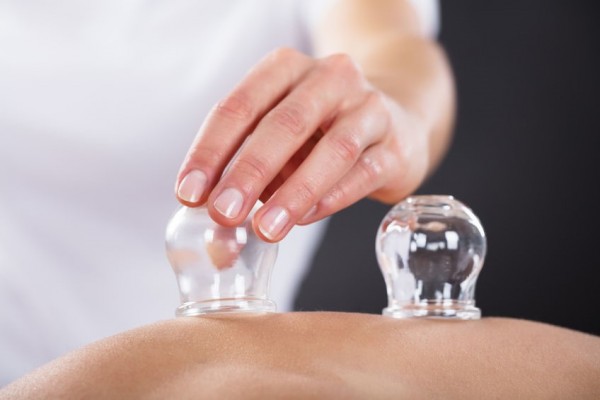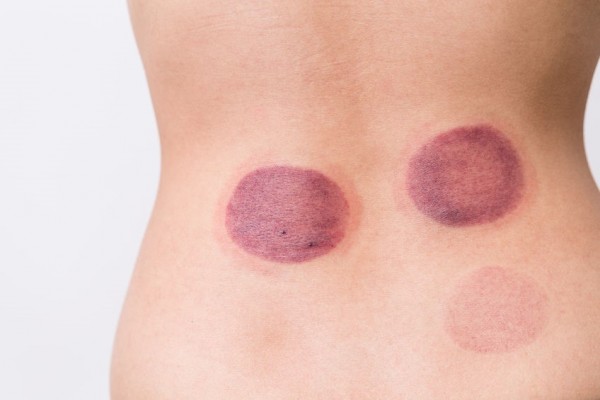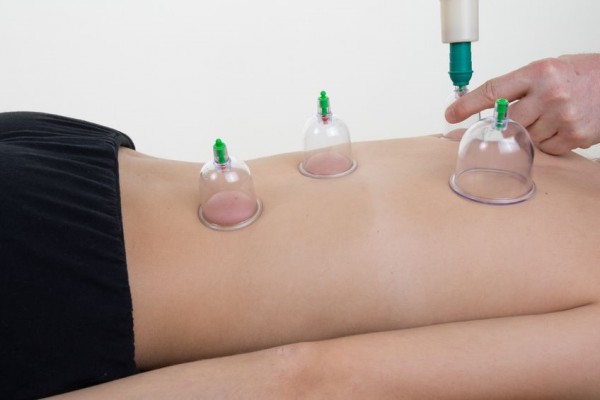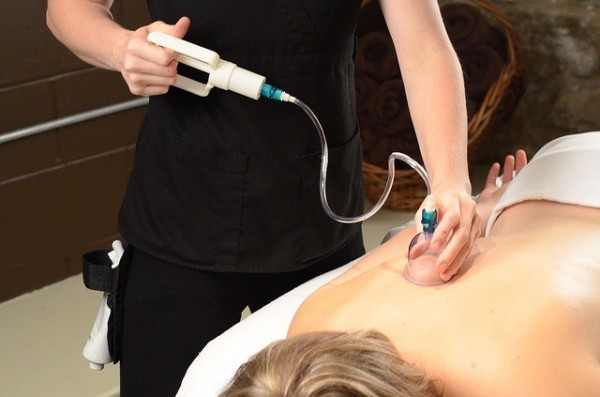
 It helps with blood circulation in the localized area. It is a safe and non-invasive technique that helps with various health problems.
It helps with blood circulation in the localized area. It is a safe and non-invasive technique that helps with various health problems.
There are actually many U.S. celebrities such as Jennifer Aniston, Gwyneth Paltrow, and David Arquette, as well as Olympic athletes like Michael Phelps who have taken part in Cupping therapy treatments.
Rushall, Kathleen. (2017, September 4). Pacific College of Oriental Medicine/THE MANY BENEFITS OF CHINESE CUPPING. Retrieved from: https://www.pacificcollege.edu/news/blog/2014/09/20/many-benefits-chinese-cupping-1
Healthline/What is Cupping Therapy? (2018, November 8). Retrieved from: https://www.healthline.com/health/cupping-therapy#takeaway
Infinity Healing Center/Cupping Moxibustion. Retrieved from:
http://infinityhealingcenter.org/cupping/
Saleh MD, Naveed. (2016, August 24). Verywellhealth/Does Cupping Work? Examining the Science. Retrieved from:
It is commonly used for back problems and other general aches and pains. People get it for many purposes, including to help with pain, inflammation, blood flow, relaxation and well-being, and as a type of deep-tissue massage. (WebMD). An increase in blood circulation can relieve muscle tension which improves blood flow and can promote cell repair. This can also lead to new connective tissues and new blood vessels created in the tissue. It loosens muscles and helps prevent muscle spasms, which is why it is popular among athletes. The idea is that this suction helps create healthier fascia, which translates into more flexibility and better muscle recovery (Flinn). It can help to release toxins, clear out blockages, create energy flow, and improve blood flow through veins and arteries.
A recent review of the treatment describes cupping as a treatment that can strengthen the body’s resistance, restore balance between positive and negative forces, remove disease-causing factors, and promote blood circulation (Shmerling, 2016). This is also the belief of many Taoists in China.
Rushall, Kathleen. (2017, September 4). Pacific College of Oriental Medicine/THE MANY BENEFITS OF CHINESE CUPPING. Retrieved from: https://www.pacificcollege.edu/news/blog/2014/09/20/many-benefits-chinese-cupping-1
WebMD/Cupping Therapy. (2018) Retrieved from: https://www.webmd.com/balance/guide/cupping-therapy#1
Healthline/What is Cupping Therapy? (2018, November 8). Retrieved from: https://www.healthline.com/health/cupping-therapy#takeaway
Flinn, Allie. The WELLNEST/7 Things to Know Before You Try Cupping. Retrieved from: https://www.humnutrition.com/blog/7-things-know-first-cupping-appointment/
Shmerling MD, Robert H. (2016, September 30). Harvard Health Publishing: Harvard Medical School/What exactly is cupping?. Retrieved from:
https://www.health.harvard.edu/blog/what-exactly-is-cupping-2016093010402
 It is also known to help with acute illnesses such as the common cold and clearing congestion, along with upper respiratory infections.
It is also known to help with acute illnesses such as the common cold and clearing congestion, along with upper respiratory infections.
Cupping can also benefit the digestive system. A few benefits include an improved metabolism, relief from constipation, a healthy appetite, and stronger digestion (Rushall, 2017).
Here are some of the health conditions Cupping could help with:
- Acne
- Allergies
- Anxiety
- Arthritis
- Asthma
- Back Pain
- Blood Disorders
- Cervical Spondylosis
- Cellulite
- Cholesterol (lowering)
- Depression
- Disc Herniation
- Dyspnea
- Eczema
- Facial Paralysis
- Fatigue
- Fertility
- Fibromyalgia
- Gynecological problems
- Hemophilia
- Herpes Zoster
- High Blood Pressure
- Hives
- Migraines
- Neck Pain
- Rheumatic Diseases
- Shingles
- Varicose Veins
Rushall, Kathleen. (2017, September 4). Pacific College of Oriental Medicine/THE MANY BENEFITS OF CHINESE CUPPING. Retrieved from: https://www.pacificcollege.edu/news/blog/2014/09/20/many-benefits-chinese-cupping-1
Shmerling MD, Robert H. (2016, September 30). Harvard Health Publishing: Harvard Medical School/What exactly is cupping?. Retrieved from:
https://www.health.harvard.edu/blog/what-exactly-is-cupping-2016093010402
WebMD/Cupping Therapy. (2018) Retrieved from: https://www.webmd.com/balance/guide/cupping-therapy#1
Healthline/What is Cupping Therapy? (2018, November 8). Retrieved from: https://www.healthline.com/health/cupping-therapy#takeaway
Chelala, Cesar. (2016, August 18). THE EPOCH TIMES/A Short History of Cupping. Retrieved from: https://www.theepochtimes.com/a-short-history-of-cupping_2141299.html
Dry cupping is very safe, and is a non-invasive treatment. Wet cupping is fairly safe too, but it is even more important that you have a well-qualified practitioner because wet cupping involves the insertion of a needle into the skin.
Note: This is a great treatment to try for ongoing pain, but it is definitely not a treatment to use for an urgent health emergency.
Side Effects of Cupping
 Cupping usually has the side effect of marks left on the skin with some discoloration, but they are not supposed to hurt, and typically disappear typically after 10 days. Other minor side effects include becoming lightheaded, sweaty or dizzy during or after a treatment. Other less common side effects are scars, burns and infections. Rare side effects include skin infections, anemia from blood loss with wet cupping, and bleeding in the skull from cupping on the skull. A practitioner should take the proper safety procedures and sterilize all equipment between patients, otherwise blood borne diseases can be spread, specifically in the case with wet cupping treatments.
Cupping usually has the side effect of marks left on the skin with some discoloration, but they are not supposed to hurt, and typically disappear typically after 10 days. Other minor side effects include becoming lightheaded, sweaty or dizzy during or after a treatment. Other less common side effects are scars, burns and infections. Rare side effects include skin infections, anemia from blood loss with wet cupping, and bleeding in the skull from cupping on the skull. A practitioner should take the proper safety procedures and sterilize all equipment between patients, otherwise blood borne diseases can be spread, specifically in the case with wet cupping treatments.
Cupping Isn’t for Everyone
Cupping isn’t the right treatment for everyone. People who should avoid cupping therapy are children under the age of four, seniors since their skin is more fragile, pregnant people for the abdomen and lower back, and people on their menstruation cycle.
Some other health scenarios where cupping should also be avoided include taking blood thinning medication, or cupping with sunburn, a wound, a skin ulcer, internal organ disorder, or after a recent trauma.
Here are some safety considerations to take before trying cupping therapy:
- Do you have a condition that may benefit from cupping?
- What health conditions does the cupping practitioner specialize in treating?
- What method of cupping does the practitioner use?
- Is the facility clean? Does the practitioner implement safety measurements?
- Wearing an apron, disposable glove, and eye protection.
- Does the practitioner have any certifications?
- What training and experience do they have?
Also, consider checking in with your current doctor to let them know you are evaluating Cupping for your specific health condition.
WebMD/Cupping Therapy. (2018) Retrieved from: https://www.webmd.com/balance/guide/cupping-therapy#1
Healthline/What is Cupping Therapy? (2018, November 8). Retrieved from: https://www.healthline.com/health/cupping-therapy#takeaway
National Center for Complementary and Integrative Health (NIH)/Cupping. Retrieved from:
https://nccih.nih.gov/health/cupping
Huzar, Timothy. (2019, March 28). MEDICALNEWSTODAY/What to know about cupping therapy. Retrieved from: https://www.medicalnewstoday.com/articles/324817.php
The Different Types of Cupping
There are two types of cupping dry and wet. Dry cupping is the noninvasive technique that just uses suction to increase blood circulation. With wet cupping the skin is slightly pierced, and a small quantity of blood flows into the cup. Some say wet cupping helps with removing harmful toxins from the body. There is also a form of cupping called “needle cupping.” Needle cupping is often done by acupuncturists, and sometimes cups are placed over an acupuncture needle after it is inserted. There is also “gliding cupping” where silicone cups are moved across the skin to provide a massage-like treatment. The new silicone cups are actually supposed to alleviate bruising, as well.
What Cupping Therapy Involves
 Cups are a round, ball shape, with an opening on one end. Historically, they were made from bamboo or clay, but today can also be made from ceramic, glass, or plastic. Glass is most commonly used. Cups are usually placed on a person’s back, shoulders, or the back of their neck. Just like acupuncture, the cups are placed on meridian lines. Cupping involves suction which is created either from a flame or a suction valve. The flame is never applied to skin though; the flame burns off the air inside the cup. Then, as the air cools inside the cup a vacuum is created.
Cups are a round, ball shape, with an opening on one end. Historically, they were made from bamboo or clay, but today can also be made from ceramic, glass, or plastic. Glass is most commonly used. Cups are usually placed on a person’s back, shoulders, or the back of their neck. Just like acupuncture, the cups are placed on meridian lines. Cupping involves suction which is created either from a flame or a suction valve. The flame is never applied to skin though; the flame burns off the air inside the cup. Then, as the air cools inside the cup a vacuum is created.
How Cupping Works
Cupping is much like the inverse of massage – rather than applying pressure to muscles, it uses gentle pressure to pull them upward (Rushall, 2017). It works as a deep-tissue therapy. It is thought to affect tissues up to four inches deep from the external skin (Rushall, 2017). This can help to release toxins, clear out blockages, and improve blood flow through veins and arteries. Cups can also be placed over wrists, hands, legs, and ankles to promote healing for specific organs that they are linked to.
Why Does Cupping Work?
There are many theories as to exactly how this works. The old Chinese medical maxim holds that pain results from the congestion, stagnation, and blockage of Qi, or vital energy, vital fluids, lymph, phlegm, and blood (Rushall, 2017). So therefore, if pain is associated with disease, suffering occurs through blockages and improper flow in the body. The body’s natural flow of vital energy is restored with Chinese cupping because it fixes the blockages opening the channels. View more of the different theories on verywellhealth.
Rushall, Kathleen. (2017, September 4). Pacific College of Oriental Medicine/THE MANY BENEFITS OF CHINESE CUPPING. Retrieved from: https://www.pacificcollege.edu/news/blog/2014/09/20/many-benefits-chinese-cupping-1
Saleh MD, Naveed. (2016, August 24). Verywellhealth/Does Cupping Work? Examining the Science. Retrieved from:
https://www.verywellhealth.com/does-cupping-work-1123947
Healthline/What is Cupping Therapy? (2018, November 8). Retrieved from: https://www.healthline.com/health/cupping-therapy#takeaway
WebMD/Cupping Therapy. (2018) Retrieved from: https://www.webmd.com/balance/guide/cupping-therapy#1
Chelala, Cesar. (2016, August 18). THE EPOCH TIMES/A Short History of Cupping. Retrieved from: https://www.theepochtimes.com/a-short-history-of-cupping_2141299.html
It is uncertain what the exact origin of cupping therapy is and where it came from. Cupping is considered to originate from China with Ge Hong, a famous Taoist herbalist and alchemist, being the first to practice it between 281 to 341 A.D.
Cupping’s Chinese Origins
 The Chinese supposedly used cattle horns or cross sections of bamboo for the cups. They would boil them in water or ignite them with fire to create negative pressure. The first use for cupping was actually in traditional Chinese surgery as an auxiliary method, then it was used for treating diseases, and eventually became a therapeutic method. The earliest record of cupping is in the Bo Shu (an ancient book written on silk), which was discovered in a tomb of the Han Dynasty (Kootenay, 2018). Centuries later it was recorded in Su Sen Liang Fang, a famous medical classic. It was stated that cupping was an effective treatment for poisonous snake bites and chronic cough. In the 19th century it became an official therapy provided in all Chinese hospitals. The Chinese use cupping now for many health scenarios including asthma, arthritic symptoms, common colds, chronic cough, indigestion problems, and skin conditions. (Kootenay, 2018). There is a saying in China: “Acupuncture and cupping, more than half of the ills cured” (ACE Massage).
The Chinese supposedly used cattle horns or cross sections of bamboo for the cups. They would boil them in water or ignite them with fire to create negative pressure. The first use for cupping was actually in traditional Chinese surgery as an auxiliary method, then it was used for treating diseases, and eventually became a therapeutic method. The earliest record of cupping is in the Bo Shu (an ancient book written on silk), which was discovered in a tomb of the Han Dynasty (Kootenay, 2018). Centuries later it was recorded in Su Sen Liang Fang, a famous medical classic. It was stated that cupping was an effective treatment for poisonous snake bites and chronic cough. In the 19th century it became an official therapy provided in all Chinese hospitals. The Chinese use cupping now for many health scenarios including asthma, arthritic symptoms, common colds, chronic cough, indigestion problems, and skin conditions. (Kootenay, 2018). There is a saying in China: “Acupuncture and cupping, more than half of the ills cured” (ACE Massage).
Egyptians Spread Cupping from Europe to America
There is mention of how Egyptians used cupping in 1,550 B.C. in the Ebers Papyrus, one of the oldest medical textbooks in the world. The Egyptians produced a text on ancient medicine that
discussed the use of cupping for conditions such as fever, pain, vertigo, menstruation imbalances, weakened appetite and accelerating the “healing crisis” of disease (ACE Massage). Egyptians introduced cupping to the Greeks and from there it spread to ancient cultures in Europe and even eventually to America. Hippocrates, known as the father of modern medicine, also used cupping in 400 BC for structural problems and treating internal diseases.
Creation of the Breast Pump & Decline of Cupping Therapy
Cupping was commonly used by European and American doctors into the 1800’s. Breast cupping became common for inflamed breasts and lactation dysfunctions and the familiar breast pump evolved from this use (ACE Massage). With new advances in technology, drugs, and medical machines interest declined in the 20th century. In the U.S. it was very popular until about 1950. Recently though, interest in the U.S. has increased since Michael Phelps showed up to the 2016 summer Olympics with dark, circular marks from cupping. In addition, many celebrities have shown their cupping marks at various events.
Today cupping is in use as a treatment for a variety of diseases around the world.
Kootenay Columbia College of Integrative Health Sciences/The History of Chinese Medicine Cupping. (2018, August 21). Retrieved from:
https://kootenaycolumbiacollege.com/the-history-of-chinese-medicine-cupping/
ACE Massage Cupping MediCupping/History of Cupping. Retrieved from:
https://massagecupping.com/history-of-cupping/
Chelala, Cesar. (2016, August 18). THE EPOCH TIMES/A Short History of Cupping. Retrieved from: https://www.theepochtimes.com/a-short-history-of-cupping_2141299.html
Rushall, Kathleen. (2017, September 4). Pacific College of Oriental Medicine/THE MANY BENEFITS OF CHINESE CUPPING. Retrieved from: https://www.pacificcollege.edu/news/blog/2014/09/20/many-benefits-chinese-cupping-1
Shmerling MD, Robert H. (2016, September 30). Harvard Health Publishing: Harvard Medical School/What exactly is cupping?. Retrieved from:
https://www.health.harvard.edu/blog/what-exactly-is-cupping-2016093010402
The healthcare industry prefers “blind placebo-controlled trials,” these are trials where neither the patient nor the researcher know which treatment is placebo and which is real. Also, pain relief can be a rather difficult thing to measure.
Here are a few of the more successful trials out there:
 This study shows the potential of Cupping to helping with Herpes Zoster, Cough, dyspnea, and other conditions. This study has been published on PLoS One in 2012. Meta-analysis showed cupping therapy combined with other TCM treatments was significantly superior to other treatments alone in increasing the number of cured patients with herpes zoster, facial paralysis, acne, and cervical spondylosis (NCBI, 2012). View An Updated Review of Efficacy of Cupping Therapy.
This study shows the potential of Cupping to helping with Herpes Zoster, Cough, dyspnea, and other conditions. This study has been published on PLoS One in 2012. Meta-analysis showed cupping therapy combined with other TCM treatments was significantly superior to other treatments alone in increasing the number of cured patients with herpes zoster, facial paralysis, acne, and cervical spondylosis (NCBI, 2012). View An Updated Review of Efficacy of Cupping Therapy.
The objective of this study was to assess the evidence for or against the effectiveness of cupping as a treatment option for pain. This included searching fourteen databases, and randomized clinical trials testing cupping for patients with any type of pain. It was published in Evidence-Based Complementary and Alternative Medicine in 2011. View Cupping for Treating Pain: A Systematic Review.
This is an evaluation of the evidence for whether cupping therapy helps with chronic back pain for adults. This was published in the Rev Lt Am Enfermagem in 2018. The main assessed outcomes were pain intensity, physical incapacity, quality of life and nociceptive threshold before the mechanical stimulus (NCBI, 2018). The results were positive for cupping helping with chronic back pain. Pain intensity showed significant reductions for patients using cupping therapy. View Cupping therapy and chronic back pain: systematic review and meta-analysis.
This is a review of whether cupping therapy has provided positive results for people suffering from neck pain. This study was published in the BMJ Open in 2018. The results showed significant reduction in pain for those receiving the cupping therapy. This was based on 18 random controlled trials. View Is cupping therapy effective in patients with neck pain? A systematic review and meta-analysis.
An experiment involving 40 patients suffering from knee arthritis, reported less pain after four months of treatment compared to those who hadn’t received the cupping treatment (Chelala, 2016).
NCBI/An Updated Review of the Efficacy of Cupping Therapy. Retrieved from: https://www.ncbi.nlm.nih.gov/pmc/articles/PMC3289625/
NCBI/ Cupping therapy and chronic back pain: systematic review and meta-analysis. Retrieved from: https://www.ncbi.nlm.nih.gov/pmc/articles/PMC6248735/
NCBI/ Cupping for Treating Pain: A Systematic Review. Retrieved from: https://www.ncbi.nlm.nih.gov/pmc/articles/PMC3136528/
NCBI/ Is cupping therapy effective in patients with neck pain? A systematic review and meta-analysis. Retrieved from: https://www.ncbi.nlm.nih.gov/pmc/articles/PMC6231582/
Chelala, Cesar. (2016, August 18). THE EPOCH TIMES/A Short History of Cupping. Retrieved from: https://www.theepochtimes.com/a-short-history-of-cupping_2141299.html
In order to learn cupping, a person must already work as a healthcare professional. Cupping training is available to Acupuncturists, Chiropractors, Massage Therapists, Physical Therapists, Naturopaths, Medical Doctors, and Registered Nurses.
It is a requirement to have completed training in the study of Anatomy & Physiology (A&P) and to have hands on bodywork experience with soft tissue manipulation, joint work and kinesiology. Then, it is a requirement to complete training and coursework specifically on cupping to obtain a certification. Here is a list of Cupping Therapy Certifications.
The Contemporary Cupping Methods curriculum is extraordinarily comprehensive in content and will teach the Healthcare Practitioner a variety of techniques, in a myriad of applications - individually and with multiple cups to address various locations and issues (The International Cupping Therapy Association). There are advanced training programs, as well. So make sure to ask your practitioner about their background education and experience level.
The International Cupping Therapy Association/Contemporary Cupping Methods Certification Program. Retrieved from: https://www.cuppingtherapy.org/pages/ccm.htm
CUPPING RESOURCE/List of Cupping Therapy Certifications. Retrieved from:
https://cuppingresource.com/list-of-cupping-therapy-certifications/
You can also look for a practitioner on one of the following website’s search directories:
International Cupping Therapy Association
ACE Massage Cupping MediCupping
 There are many ways the practitioner can create suction. They can either use a flame to heat the inside of the cup, or use rubber pumps to create suction. They can heat it with fire using alcohol, herbs, or paper placed in the cup. But, no flames ever come near the skin. After the cup is placed on the skin, the air instantly cools which creates a vacuum and the skin along with muscles is pulled up into the cup. This can cause the skin to turn red as the blood vessels react to the change in pressure.
There are many ways the practitioner can create suction. They can either use a flame to heat the inside of the cup, or use rubber pumps to create suction. They can heat it with fire using alcohol, herbs, or paper placed in the cup. But, no flames ever come near the skin. After the cup is placed on the skin, the air instantly cools which creates a vacuum and the skin along with muscles is pulled up into the cup. This can cause the skin to turn red as the blood vessels react to the change in pressure.
Often cupping therapy is applied to the back, but can be used for treatment on thighs, arms, and other places throughout the body. For dry cupping, the cups are placed on the skin anywhere from 5 to 10 minutes, sometimes 15. With wet cupping the cups are placed on the skin for around 3 minutes with a mild suction. The therapist then removes the cup and uses a small scalpel to make light, tiny cuts on your skin (WebMD, 2018). Then, they will do another cup suction to draw out the blood into the cup.
There are also methods where a practitioner will slide the cups around, called “gliding cupping,” but will place oil on your back to improve movement. After the cups are removed, you may receive some ointment or bandages to prevent infection. Any mild bruising or other marks usually go away within 10 days of the session (Healthline, 2018).
Does Cupping Hurt?
Some people say it doesn’t hurt, and it feels like a massage. It is also said to feel like an inverse massage because instead of applying pressure the skin tissues are being lifted (suctioned) away from the skeletal system. Some say it feels weird. It is said to provide initial discomfort, and once that goes away it is pretty relaxing.
WebMD/Cupping Therapy. (2018) Retrieved from: https://www.webmd.com/balance/guide/cupping-therapy#1
Flinn, Allie. The WELLNEST/7 Things to Know Before You Try Cupping. Retrieved from: https://www.humnutrition.com/blog/7-things-know-first-cupping-appointment/
Healthline/What is Cupping Therapy? (2018, November 8). Retrieved from: https://www.healthline.com/health/cupping-therapy#takeaway
Rushall, Kathleen. (2017, September 4). Pacific College of Oriental Medicine/THE MANY BENEFITS OF CHINESE CUPPING. Retrieved from: https://www.pacificcollege.edu/news/blog/2014/09/20/many-benefits-chinese-cupping-1
WebMD/Cupping Therapy. (2018) Retrieved from: https://www.webmd.com/balance/guide/cupping-therapy#1
Infinity Healing Center/Cupping Moxibustion. Retrieved from:
http://infinityhealingcenter.org/cupping/
Healthline/What is Cupping Therapy? (2018, November 8). Retrieved from: https://www.healthline.com/health/cupping-therapy#takeaway
National Center for Complementary and Integrative Health (NIH)/Cupping. Retrieved from:
